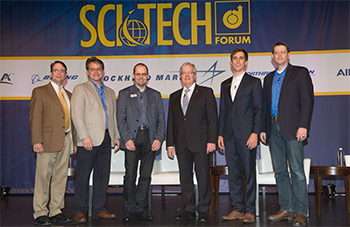Mainstreaming Urban Air Mobility Written 10 January 2018
Panelists: Moderator Bruce Holmes, vice president for digital aviation, SmartSky Networks LLC; Carl Dietrich, chief technology officer and co-founder, Terrafugia; Mark Moore, director of engineering, Uber Elevate; Mark Cousin, senior vice president of flight demonstrators, Airbus; Brian Yutko, vice president of research and development, Aurora Flight Sciences
By Tom Risen, Aerospace America staff reporter (2017-2018)

Companies are building and testing electric vertical takeoff and landing aircraft, or eVTOLs, to ferry people above car traffic, but they need to be safe, affordable and energy-efficient to become part of a daily commute. Entrepreneurs and engineers detailed how their companies are tackling these challenges Jan. 10 during the “Dude, Where’s My Flying Car” panel at the 2018 AIAA SciTech Forum in Kissimmee, Florida.
To build an urban air mobility ecosystem for these aircraft, vehicle manufacturers will have to coordinate with numerous types of organizations, including real estate providers to create landing pads known as skyports, said Mark Moore, director of engineering at California-based Uber Elevate.
“We will never build a vehicle, but we want to make sure that our partners who are building vehicles are successful and that these aircraft are as community-friendly as possible,” Moore said, explaining Uber Elevate’s partnership with manufacturers and regulatory agencies to clear the way for Uber to provide on-demand flight through a mobile app. Some of the companies partnering with Uber have not publicly released their aircraft concepts, so Moore unveiled a “common reference model” that illustrates some of the challenges these electric aircraft will face, including battery energy density and noise pollution.
“The batteries are almost there, because the longest distance we need to travel in between skyports is only 45 miles,” Moore said.
Noise and expense are two of the major reasons helicopters are not more widely used for urban transport, and eVTOLs will have to improve upon both to gain public acceptance, said Mark Cousin, senior vice president of flight demonstrators at Airbus.
Cousin predicted there would be “a multitude” of aircraft designs for the new generation of urban air mobility, referring to the numerous types of cars on the road. Airbus holds true to that example: a prototype of its CityAirbus air taxi will test fly at the end of 2018, he said. A full-scale demonstrator of the tandem tilt-wing Vahana aircraft by Airbus’ Silicon Valley arm, A3 [pronounced “A cubed”], “will fly within the next month,” he said.
